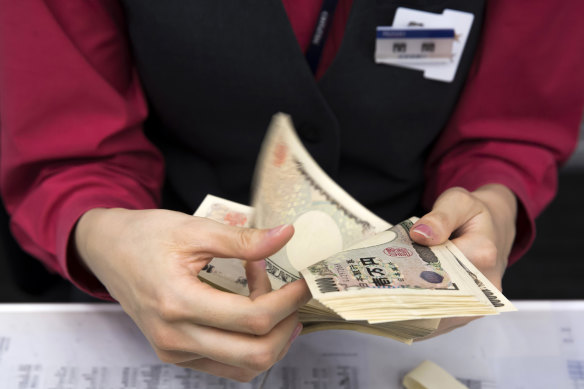
The BoJ, with a targeted policy rate of zero to 0.1 per cent that was aimed at igniting inflation, is not only on the verge of raising its policy rate but also unveiling plans to start unwinding its ¥6 trillion ($A59 billion) a month buying of its government’s bonds.
The big spread between US and Japanese rates that has persisted for decades -- because the BoJ maintained zero to negative rates for decades while hoovering up bonds and even equities during its era of stagnation and disinflation -- spawned a multitude of financial trades.
Japan is the world’s largest creditor and, given the paucity of positive returns in its domestic market, the capital from its growth-poor but savings-rich economy has flowed out to the rest of the world for decades.
Known as carry trades, investors – including Japanese retail investors, the proverbial “Mrs Watanbes,” or Japanese housewives – borrowed at ultra-low cost to invest in higher yielding assets offshore.
The US dollar and dollar-denominated assets; the Australian and New Zealand dollars; the Mexican peso and even the Argentinian peso have been on the other end of those yen-funded trades.

As it has modestly raised the caps on its yields, and the markets have become convinced that the yield curve control measures will be abandoned, there has recently been a modest reversal of the longer-term depreciation of the yen against other major currencies,Credit: Bloomberg
There also been a lot of hedge fund activity and a lot of shorting of the yen during the period when other currencies, particularly the US dollar, were strengthening because of their higher interest rate regimes.
Both the carry trades and short positions have been rapidly closing out in the past few weeks as the prospect of the yen-dollar spread strengthened. The level of shorting shrunk by the most in more than 13 years in the middle of July, as leveraged hedge funds closed down their positions.
The Japanese stockmarket, which historically has had an inverse relationship (as most sharemarkets do) with interest rates, has also slumped. It was trading at record levels in mid-July but has since slumped about nine per cent.
The Fed’s position is easily explicable and well understood. US inflation has been falling steadily and, if the past three months’ data were extrapolated, would be within the Fed’s targeted level.
The BoJ’s predicament is quite different. It tried for decades to stimulate inflation and finally succeeded last year.
The famed Japanese savings rate is flat-lining, with consumers using their savings to offset the increased costs of living.
It wanted to end the era of stagnation and deflation and hoped that sparking inflation would lead to a virtuous cycle of price and wage increases and economic growth. It used every monetary policy option available to it to do so.
Now it has inflation, which is running at 2.8 per cent, but the green shoots of economic growth experienced last year have withered. Forecast economic growth this year is a meagre 0.9 per cent.
There have been wage rises, but those increases have been less than the inflation rate – real wages are still falling. The famed Japanese savings rate is flat-lining, with consumers using their savings to offset the increased costs of living, and companies are now reluctant to pass on inflation-generated higher costs because consumers are so cautious.
It might appear perverse that, in these circumstances, the BoJ is going to raise interest rates but it needs to both reassure households that it will shave the inflation rate, and it needs to put a floor under the yen to avoid more inflationary pressures from the higher cost of imported goods.
Loading
It’s a delicate moment for the BoJ. If it finesses the moment, it can maintain a stronger yen and the hope of generating more of the growth and increases in wages and spending it saw last year. If it bungles it, the currency could easily plunge back to multi-decade lows and Japan back into the economic winter that enveloped it after its property sector bubble burst in the late 1980s.
Meanwhile, the question marks over the relationships between the yen and third currencies, particularly the US dollar, have created a risk-off environment for investors and traders and will continue to generate volatility and risk unless and until those uncertainties are resolved.
If the BoJ were to pull off the normalisation of Japan’s monetary policies, it would represent a fundamental shift in the framework of global capital flows that has been in place for decades, with Japanese capital flowing away from the US, Europe and higher-yielding economies like Australia as ‘Mrs Watanabe’ brings her household’s savings home.









 Add Category
Add Category